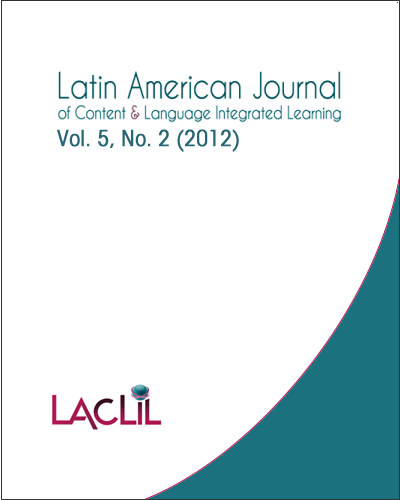CLIL implementation in Italian schools: can the long ago employed teacher be trained effectively? The Italian protagonists’ voice
DOI:
https://doi.org/10.5294/laclil.2012.5.2.9Keywords:
input lingüístico, educación bilingüe, aprendizaje de idiomas, motivación en el aprendizaje, necesidades formativas, objetivos de formación.Abstract
Most Italian upper schools will have to offer at least one subject in a foreign language as part of the national curriculum starting next year. This paper aims to report the results of a survey we carried out between April and June 2011 in order to get the feel of the teachers’ expectations, fears and thoughts in the wake of the ‘CLIL revolution’ in our country. The overall aim of our research is to offer those in charge of the project the possibility to hear the voices of some of the teachers who are being asked to take on a task requiring considerable extra work in a very complex moment for our country, so as to at least attempt to finetune their decisions to actual reality.
A partir del próximo año los institutos italianos estarán obligados a impartir una asignatura en un idioma estranjero como parte del curriculo nacional.
Objetivo de esta ponencia es informar de los resultados de una encuesta realizada entre abril y junio de 2011 con el fin de sondear las expectativas de los profesores, sus temores y opiniones con vista a la revolución CLIL en Italia. El fin de la investigación es ofrecer a los responsables del proyecto la posibilidad de escuchar las voces de los docentes, a los que se le pedirá una gran mole de trabajo extra en un momento especialmente complejo para el país, con el fin de afinar las modalidades de realización del proyecto mismo con las exigencias de los profesores de instituto y la realidad actual.
Downloads
References
Cardona, M (ed.) (2008). Apprendere le lingue in ambiente CLIL. Aspetti teorici e percorsi applicativi. Bari: Cacucci Editore.
Coonan, CM (2009). Opportunità di usare la LS nella lezione CLIL: importanza, problemi, soluzioni. Studi di Glottodidattica, 2, 20-34.
Coonan, CM (2002). La lingua straniera veicolare. Torino: UTET.
Eskey, DE (1997). Syllabus Design in Content-Based Instruction. In MA Snow & DA Brinton (eds.), The Content-Based Classroom: Perspectives on Integrating Language and Content (132-141). White Plains, NY: Longman.
Di Martino, E (forthcoming a). Content and Language Integrated Learning: la voce dei più giovani. Resoconto di un’indagine sulle preoccupazioni e le attese degli studenti. Studi di Glottodidattica.
Di Martino, E (forthcoming b). Content and Language Integrated Learning: resoconto di un’indagine sulle preoccupazioni e le attese dei docenti. Studi di Glottodidattica.
Di Martino, E (2004). Teaching and Learning English in the Age of the Global Village - A Teacher's Journey into Qualitative Research. Napoli: Edizioni Scientifiche Italiane.
Di Sabato, B (2008). La didattica delle lingue in lingua straniera: resoconto di un'esperienza in ambiente universitario. In M Cardona (ed.), Apprendere le lingue in ambiente CLIL. Aspetti teorici e percorsi applicativi (137-151). Bari: Cacucci Editore.
Di Sabato, B & Cordisco, M (2006). Lingua e contenuti: un’integrazione efficace. Special issue of Rassegna Italiana di Linguistica Applicata, 1.
European Council (2011). Council Conclusions on Language Competences to Enhance Mobility, 3128th EDUCATION, YOUTH, CULTURE and SPORT Council meeting, Brussels, 28 and 29 November 2011. Retrieved 3/5/2012 from http://www.consilium.europa.eu/Newsroom. 1.
Honig, I. (2010). Assessment in CLIL – A Case Study. VIEWS. In U Smit, B Schiftner, C Dalton-Puffe (eds), VIenna English Working PaperS. Special Issue of Current Research on CLIL, 19, 3, 36-41.
Jansen, H. (2010). The Logic of Qualitative Survey Research and its Position in the Field of Social Research Methods. Forum: Qualitative Social Research, 11, 2. Retrieved 3/5/2012 from http://www.qualitative-research.net/index.php/fqs/article/view/1450/2946.
Mehisto, P (2009). Talk. At IATEFL 2009 CLIL Debate. Retrieved 3/5/2012 from http://www.onestopenglish.com/transcript-of-the-clil-debate-iatefl-09-cardiff/501068.article.
Serra, C (2007). Assessing CLIL in Primary School: a Longitudinal Study. The International Journal of Bilingual Education and Bilingualism, 10, 5, 582-602.
Strategic Framework for European Cooperation in Education and Training ("ET 2020") (2009). Retrieved 3/5/2012 from http://ec.europa.eu/education/lifelong-learning-policy/policy-framework_en.htm.
Wolff, D (1997). Content-Based Bilingual Education or Using Foreign Languages as Working Languages in the Classroom. In D Marsh, B Marsland, T Nikula (eds.), Aspects of Implementing Plurilingual Education (51-64). Jyväskylä, Finland: University of Jyväskylä.
Downloads
Published
How to Cite
Issue
Section
License
This Journal and its articles are published under the Creative Commons CC BY 4.0 DEED Attribution 4.0 International license. You are free to: Share — copy and redistribute the material in any medium or format for any purpose, even commercially. Adapt — remix, transform, and build upon the material for any purpose, even commercially. The license cannot revoke these freedoms as long as you follow the terms of the license.








